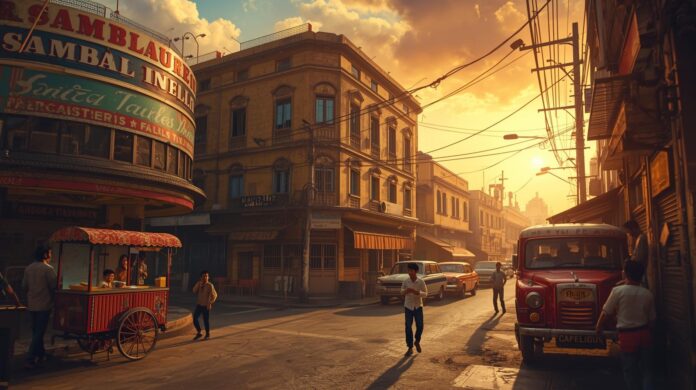Today, Sambalpur has turned out to be a comparatively larger city than what we had seen till the year 1977 when we passed out our High School Certificate Examination. At that time, there were very few hotels for visitors and tourists to stay in. But the number of hotels for tiffin and meals was a little or much better. Children normally have a weakness for food, and they are so used to it outside that, at home, they feel diffident to take food despite scolding from parents. During our time, we had limitations. But today, the sky is the limit. From fast food to papdi chat, food corners offer a variety for children.
Go to any place, and you will find food corners in plenty. By “hotel,” I mean places where tiffin and meals are available, and not the ones where people come for lodging and boarding. These places or hotels were food corners for us children in our time.
Before I talk about the food corners in the city during our time, let me have a glance at some of the spots where we children moved for spending some time in the lap of nature and getting something to eat. At that time, there was large-scale sugarcane cultivation around the city — one was Bhatra and the other was Dhankauda. We children moved over to these places and requested the farmers to provide us with some. They also used to squeeze sugarcane for juice and offered us very little, as they had to prepare jaggery out of it. At that time, there were sugar mills in Bolangir and Bargarh. But I cannot say for certain as to where they used to send their production.
There were also mango and guava groves around the city, but we confined ourselves mostly to the ones in Dhanupali and Govindtola, our localities.
The first and foremost food corner that I remember was the one adjacent to the gate of the Ashoka Talkies, which has been razed to the ground since long. At that time, for us children, the only source of entertainment was cinema in the absence of mobile sets and television. So whenever we got the chance, we went to the Talkies and enjoyed movies. The food corner was managed by a healthy person with curly hair. He prepared small round Aluchups, Chana and red chutney and mixed up the three for a tasty chat with extra onion and Namkeen, and charged twenty-five paise. Later, he raised the price to fifty paise and one rupee. Since our school was nearer, we also made it convenient to enjoy the chat during recess.
There was another food corner adjacent to the gate on the other side, managed by a slim person who prepared Aluchup, Samosa, Chana, and Khajur, which was made of probably Maida and Suji. The item is still available in tea shops in the city. We went to the second food corner often for a change in taste. Today both the corners are there, but being managed by different persons selling different items.
The other food corners that instantly come to mind are the ones that existed near Luxmi Talkies and Gaiety Talkies. Both these had doors towards the road in addition to doors opening towards the cinema halls so that both the public and cinegoers could have tiffin. Both corners provided Aluchup, Samosa, and Chana, and people rushed to them during intermission or “half-time,” as we called it. Today both the talkies do not exist. Though the food corner in Luxmi Talkies has also been closed down, the one in Gaiety Talkies still runs with the sale of additional sweets.
As far as I remember, the rate of a Samosa or Aluchup was ten to fifteen paise. Since Luxmi Talkies was on the main chowk, there were not many Thelas outside the hall. But outside the Gaiety Talkies, there were Thelas selling alumudhi, eggs, and other items due to space on the road close to the boundary of the hall. On the first floor of Ashoka Talkies, there was a café selling coffee and snacks. But we children hardly made use of it, since we confined ourselves to the ground floor accommodating first class, second class, and third class ticket holders.
In addition to the food corners in the three cinema halls, there were a number of hotels in the city scattered over different places. Town Hotel in Golebazar and Pravat Hotel in Dalaipara specialised mostly in lunch and dinner. On the other hand, Malini Café, Punjab Chand Hotel, and Bihar Hotel in a row in front of the Luxmi Talkies prepared both tiffin and meals. Malini Café specialised in Masala Dosa, Upama, and other South Indian items, whereas Punjab Chand Hotel specialised in Samosa, Aluchup, and Kima Chup, and Bihar Hotel prepared Samosa, Aluchup, and sweets. All the hotels prepared lassi during summer.
Besides, there was one hotel near Ashoka Talkies which prepared Samosa and Ganthia, one near Town Hotel which prepared round Alu Pakodi, and one on Baidyanath Chowk which again prepared Samosa and Ganthia. These three hotels were known for their yellowish chutney. There were also hotels in almost all Paras, on the outskirts of the city, in Kutchery area, near the hospital, and the Gangadhar Meher College.
Samosa, Aluchup, Biribara, Dahibara, Chanabara, Piaji, Pakodi, and Gulgula were hot favourites with the people. Bread Pakoda, Chaka Pitha, and Chaul Bara were quite unknown and came to the market later from other places. Sambar Bada and Idli were mostly available in South Indian hotels. Fast food like Chowmein, Pizza, and Burger were almost absent, which have become hot favourites with the children of today.
Today, in almost all areas and chowks, there are Thelas selling Gupchup or Golgappa, Samosa, and Kachodi chat. In recent times, Khaogali, on the model of certain other cities in the state, has come up near Jail Chowk and some other places. Baidyanath Chowk near Golebazar has also turned out to be the most attractive place in this regard, offering a variety of items. But in our time, choice was limited.
There was Maharaj, a slim person who stood with his Thela in Baidyanath Chowk and sold Gupchup, Papdi chat, Kachodi chat, and Kanji Bada. He came at around 3 or 3.30 PM and finished whatever he had brought by 6.30 or 7 PM. There was always a long queue for his Gupchup, and people came from far and wide to have a taste of it. Sometimes our turn in the queue never came, as the place was far from our locality and we reached late. At that time, his was the only Thela in Baidyanath Chowk selling these items. But today, it has become the chat hub of the city. Alutiki, one of our favourite items, has become rare nowadays, being available only in a few places.
There were also hotels in Nandapara, Jharuapara, Mohantypara, and other areas. Nirmal and Ramgarhia Hotels near Kansaripara specialised in Imriti and other sweets, and the hotel near Pirbaba Chowk prepared Kachodi, Samosa, Ganthia, and Aluchup. While coming back to our area via Jail Chowk, Lala Hotel at the entrance of Commissioner’s Colony prepared Samosa, Aluchup, and tamarind khata, and Sahu and Nandy Hotels in Dhanupali Chowk prepared Samosa and Aluchup along with sweets.
As a city, Sambalpur has grown in size and population. Accordingly, hotels and food corners have also grown in number. Most of the hotels that existed during our time are still there, managed from one generation to another. For us, these were food corners. Today, more and more food corners and restaurants have come up in the city and are doing a good service the way the hotels did in our time.
It is not that the old hotels have lost their demand or value just because the children have a preference for fast food. Along with fast food corners, they are doing equally good business, as the craze for Samosa, Aluchup, Piaji, Pakodi, Masala Dosa, Idli, Dahibara, and Gupchup is still there, except for Gulgula or Atabara, which seems to have become rare. Chaul Bara, Chaka Pitha, Bread Pakoda, and certain other items have gained much popularity in the meantime. Chaka Pitha is more popular in Bolangir and Sonepur areas. In the city of Sambalpur today, Chaul Bara and Bread Pakoda seem to have an edge over Chaka Pitha, which is available in limited places.
Items in the fast food section can hardly be counted on fingertips. Anyway, in our time, we enjoyed whatever we got to eat the way children are enjoying their items today. It is really difficult to forget the hotels of our time in the city of Sambalpur for their good service and the variety of items that they served to us. We children, who have grown up today, will cherish them forever in our memory.
The views expressed are the writer’s own)

Mr. Prafulla Kumar Majhi,
Retired Asst. Director, A. I. R, is an eminent Scholar and freelance writer in English & Odia. His areas of interests are sociocultural, economic, literary, historical and analytical studies and writings.
Email: airprafulla61@gmail.com
Mobile.9861007190

